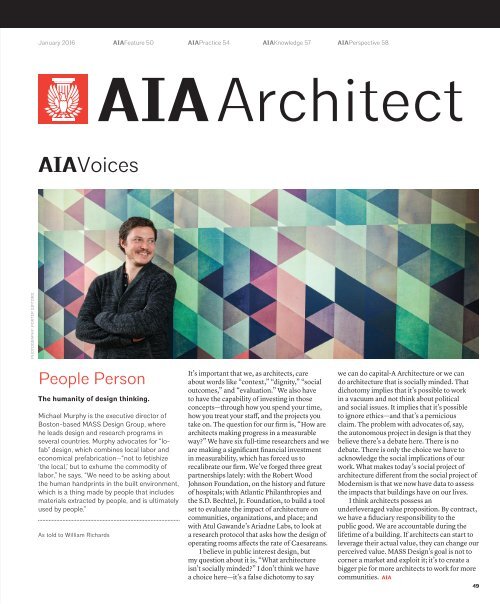Architect 2016-01
Create successful ePaper yourself
Turn your PDF publications into a flip-book with our unique Google optimized e-Paper software.
January <strong>2<strong>01</strong>6</strong> AIAFeature 50 AIAPractice 54 AIAKnowledge 57 AIAPerspective 58<br />
AIA <strong>Architect</strong><br />
AIAVoices<br />
PHOTOGRAPHY: PORTER GIFFORD<br />
People Person<br />
The humanity of design thinking.<br />
Michael Murphy is the executive director of<br />
Boston-based MASS Design Group, where<br />
he leads design and research programs in<br />
several countries. Murphy advocates for “lofab”<br />
design, which combines local labor and<br />
economical prefabrication—“not to fetishize<br />
‘the local,’ but to exhume the commodity of<br />
labor,” he says. “We need to be asking about<br />
the human handprints in the built environment,<br />
which is a thing made by people that includes<br />
materials extracted by people, and is ultimately<br />
used by people.”<br />
As told to William Richards<br />
It’s important that we, as architects, care<br />
about words like “context,” “dignity,” “social<br />
outcomes,” and “evaluation.” We also have<br />
to have the capability of investing in those<br />
concepts—through how you spend your time,<br />
how you treat your staff, and the projects you<br />
take on. The question for our firm is, “How are<br />
architects making progress in a measurable<br />
way?” We have six full-time researchers and we<br />
are making a significant financial investment<br />
in measurability, which has forced us to<br />
recalibrate our firm. We’ve forged three great<br />
partnerships lately: with the Robert Wood<br />
Johnson Foundation, on the history and future<br />
of hospitals; with Atlantic Philanthropies and<br />
the S.D. Bechtel, Jr. Foundation, to build a tool<br />
set to evaluate the impact of architecture on<br />
communities, organizations, and place; and<br />
with Atul Gawande’s Ariadne Labs, to look at<br />
a research protocol that asks how the design of<br />
operating rooms affects the rate of Caesareans.<br />
I believe in public interest design, but<br />
my question about it is, “What architecture<br />
isn’t socially minded?” I don’t think we have<br />
a choice here—it’s a false dichotomy to say<br />
we can do capital-A <strong>Architect</strong>ure or we can<br />
do architecture that is socially minded. That<br />
dichotomy implies that it’s possible to work<br />
in a vacuum and not think about political<br />
and social issues. It implies that it’s possible<br />
to ignore ethics—and that’s a pernicious<br />
claim. The problem with advocates of, say,<br />
the autonomous project in design is that they<br />
believe there’s a debate here. There is no<br />
debate. There is only the choice we have to<br />
acknowledge the social implications of our<br />
work. What makes today’s social project of<br />
architecture different from the social project of<br />
Modernism is that we now have data to assess<br />
the impacts that buildings have on our lives.<br />
I think architects possess an<br />
underleveraged value proposition. By contract,<br />
we have a fiduciary responsibility to the<br />
public good. We are accountable during the<br />
lifetime of a building. If architects can start to<br />
leverage their actual value, they can change our<br />
perceived value. MASS Design’s goal is not to<br />
corner a market and exploit it; it’s to create a<br />
bigger pie for more architects to work for more<br />
communities. AIA<br />
49

















